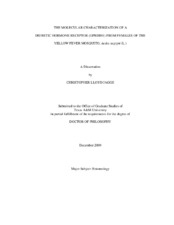| dc.contributor.advisor | Pietrantonio, Patricia V. | |
| dc.creator | Jagge, Christopher Lloyd | |
| dc.date.accessioned | 2011-02-22T22:23:35Z | |
| dc.date.accessioned | 2011-02-22T23:44:31Z | |
| dc.date.available | 2011-02-22T22:23:35Z | |
| dc.date.available | 2011-02-22T23:44:31Z | |
| dc.date.created | 2009-12 | |
| dc.date.issued | 2011-02-22 | |
| dc.date.submitted | December 2009 | |
| dc.identifier.uri | https://hdl.handle.net/1969.1/ETD-TAMU-2009-12-7217 | |
| dc.description.abstract | In the yellow fever mosquito, Aedes aegypti (L.), hemolymph-circulating diuretic hormones act upon the renal organs (Malpighian tubules) to regulate primary urine composition and secretion rate; however, the molecular endocrine mechanisms underlying rapid water elimination upon adult eclosion and blood feeding are not fully understood. Bioinformatic analysis of the current Aedes aegypti genome assembly reveals only a single predicted corticotropin releasing factor (CRF)-like diuretic hormone 44 (DH44) gene, but two DH44 receptor genes. The tissue expression profiles of the DH44 receptor(s), and specifically the identity of the DH44 receptor(s) in the Malpighian tubule, are undetermined in any mosquito species.
This dissertation shows that Vectorbase gene ID AAEL008292 encodes a DH44 receptor (AaegGPRdih1) transcribed in Malpighian tubules. Sequence analysis and transcript localization indicate that AaegGPRdih1 is the co-ortholog of the Drosophila melanogaster DH44 receptor (CG12370-PA). The presence of conserved amino acid residues between AaegGPRdih1 and vertebrate CRF receptors suggests this mosquito receptor modulates multiple G protein-dependent intracellular signaling pathways. Quantitative PCR analysis of a time course of Malpighian tubule cDNA reveals AaegGPRdih1 abundance increases paralleling periods of observed urination. This suggests that target tissue receptor biology is linked to the known periods of release of diuretic hormones from the nervous system, pointing to a common up-stream regulatory mechanism. Higher relative abundance of AaegGPRdih1 transcript in female Malpighian tubules 24 hours after blood feeding suggests a role for AaegGPRdih1 in the excretion of nitrogen waste. RNA-mediated silencing to establish the significance of AaegGPRdih1 to mosquito Malpighian tubule physiology was inconclusive. | en |
| dc.format.mimetype | application/pdf | |
| dc.language.iso | en_US | |
| dc.subject | Aedes aegypti | en |
| dc.subject | yellow fever mosquito | en |
| dc.subject | diuresis | en |
| dc.subject | renal physiology | en |
| dc.subject | Malphighian tubule | en |
| dc.subject | GPCR | en |
| dc.subject | diuretic hormone | en |
| dc.subject | receptor | en |
| dc.subject | GPRdih1 | en |
| dc.subject | GPRdih2 | en |
| dc.title | The Molecular Characterization of a Diuretic Hormone Receptor (GPRdih1) From Females of the Yellow Fever Mosquito, Aedes aegypti (L.) | en |
| dc.type | Book | en |
| dc.type | Thesis | en |
| thesis.degree.department | Entomology | en |
| thesis.degree.discipline | Entomology | en |
| thesis.degree.grantor | Texas A&M University | en |
| thesis.degree.name | Doctor of Philosophy | en |
| thesis.degree.level | Doctoral | en |
| dc.contributor.committeeMember | Burghardt, Robert | |
| dc.contributor.committeeMember | Coates, Craig | |
| dc.contributor.committeeMember | Mulenga, Albert | |
| dc.type.genre | Electronic Dissertation | en |
| dc.type.material | text | en |


